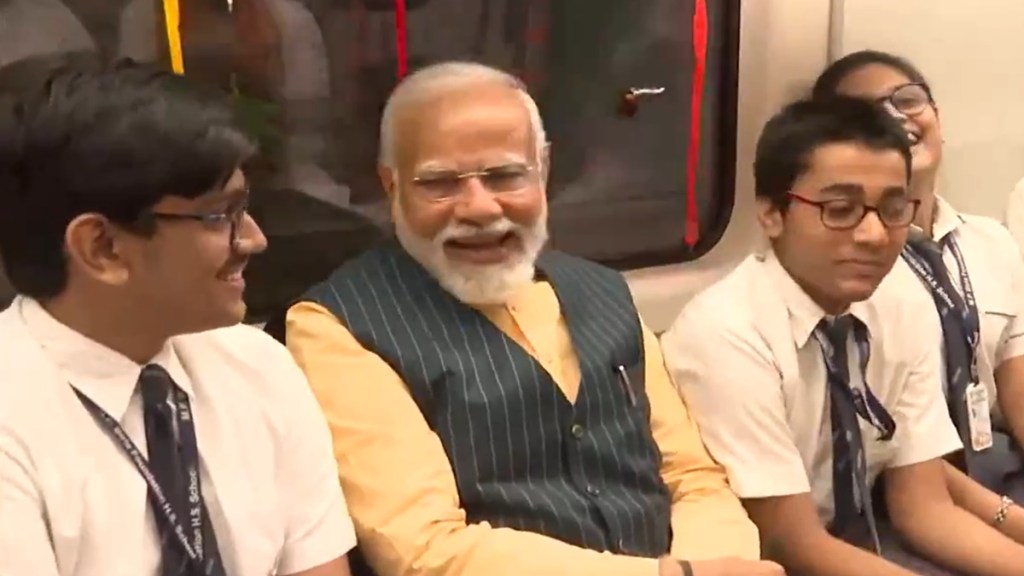Prime Minister Narendra Modi inaugurated a significant transportation milestone in Kolkata, marking the commencement of India’s first metro train service through an under-river tunnel.
The Inaugural Event
- The inauguration ceremony witnessed Prime Minister Narendra Modi launching the metro train service between Howrah Maidan and Esplanade in Kolkata.
- This inaugural event also celebrated the opening of India’s first under-river tunnel, spanning 4.8 kilometers between Howrah Maidan and Esplanade, with a section of 1.2 kilometers positioned beneath the Hooghly River.
Notable Features
- The tunnel, positioned 30 meters below the Hooghly River, is the first transportation tunnel beneath a significant river in India.
- Prime Minister Modi actively participated in the event by boarding the metro train, interacting with students, and engaging with the enthusiastic crowd at the metro station upon his arrival.
Expansion of Metro Services
- Alongside the Howrah Maidan-Esplanade section, PM Modi also inaugurated metro railway services from various other locations, further expanding Kolkata’s metro network.
- These locations include Kavi Subhash Metro, Majerhat Metro, Kochi Metro, Agra Metro, Meerut-RRTS section, Pune Metro, and Esplanade Metro in Kolkata.
Project Overview
- The tunnel is part of the East-West Metro Corridor project, stretching from Sector V to Sealdah, covering a total of 16.6 kilometers, out of which 10.8 kilometers are underground.
- Initially proposed in Kolkata’s master plan in 1971, the project received approval in July 2008, drawing inspiration from Kolkata’s pioneering metro and the success of Delhi’s metro network.
Impact and Benefits
- Costing Rs 4,138 crore, the East-West Metro stretch aims to alleviate traffic congestion, enhance air quality, and improve mass transit accessibility in Kolkata.
- The project promises significant benefits for commuters from distant areas such as Hooghly, Midnapore, and Howrah, as well as neighboring states, by providing efficient connectivity and urban mobility.
Project Progress and Challenges
- The East-West Metro corridor project commenced in 2009, with tunneling under the River Hooghly starting in 2017.
- However, delays, including aquifer bursts and ground subsidence, have impacted the project’s completion timeline.
Budget Allocation and Commitment
- The project aligns with efforts to complete pending railway infrastructure projects in West Bengal, with a substantial increase in budget allocation over the past nine years.
- Expenditure on metro projects in Kolkata and its vicinity surged from Rs 5,981 crore before 2014 to Rs 18,212 crore between 2014 and 2023, reflecting a significant acceleration in project completion efforts.
Multiple Choice Questions (MCQ):
- What milestone was celebrated during the inauguration ceremony in Kolkata?
- A) Launch of India’s first metro train service
- B) Opening of India’s first under-river tunnel
- C) Expansion of Kolkata’s airport
- D) Commencement of a new highway project
- Answer: B) Opening of India’s first under-river tunnel
- Which river does the under-river tunnel span beneath?
- A) Ganges
- B) Yamuna
- C) Hooghly
- D) Brahmaputra
- Answer: C) Hooghly
- What is the total length of the East-West Metro Corridor project?
- A) 20.6 kilometers
- B) 14.8 kilometers
- C) 16.6 kilometers
- D) 25.2 kilometers
- Answer: C) 16.6 kilometers
- What is the primary objective of the East-West Metro stretch?
- A) Enhancing road transportation
- B) Improving air quality
- C) Boosting maritime trade
- D) Promoting tourism
- Answer: B) Improving air quality
- What factors have caused delays in the completion of the East-West Metro corridor project?
- A) Political disputes
- B) Labor strikes
- C) Aquifer bursts and ground subsidence
- D) Financial constraints
- Answer: C) Aquifer bursts and ground subsidence
